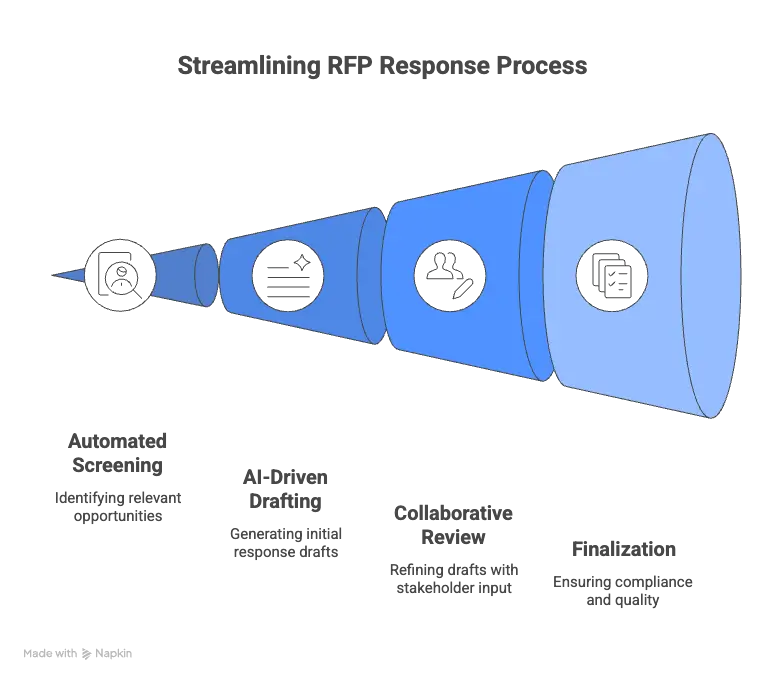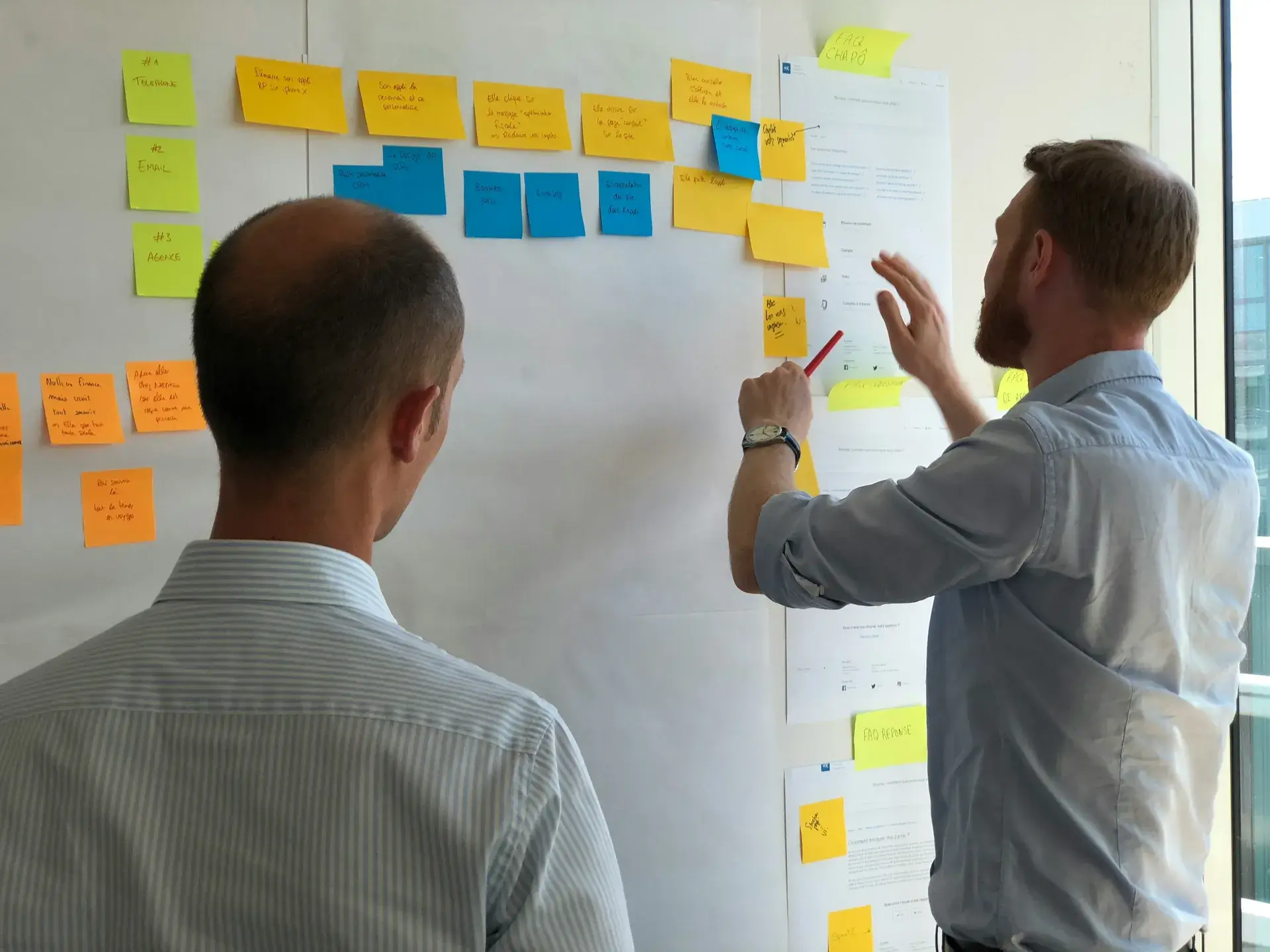Revolutionizing the RFP response process
Automated tools like Tenderbolt AI, Loopio and Responsive make this transformation possible. These platforms help streamline repetitive tasks, enabling proposal teams to focus on key strategic elements rather than spending valuable time on manual processes. By improving efficiency, they not only save time but also raise the standard of RFP responses, ensuring both consistency and compliance with critical regulatory requirements.
Win more deals effortlessly
Utilizing automated RFP software empowers teams to handle multiple projects simultaneously and respond to an increased number of opportunities. The result? Faster, more efficient production of winning responses that dramatically boost the likelihood of success.
Understanding the Basics of Automated RFP
How Automation Transforms the RFP Screening Process
Automation is revolutionizing the RFP response process by reshaping its early stages. It facilitates rapid analysis of incoming proposals, identifying which ones are worth pursuing. Instead of manually reviewing every RFP, automated tools employ a thorough requirements analysis, scanning documents for mandatory criteria, potential red flags, and compliance elements.
This empowers your team to make quick, informed go/no-go decisions, ensuring effort is focused exclusively on RFPs with a realistic chance of success.
Through leveraging a robust content library and machine learning, these tools compare RFP qualifications against your organization’s capabilities and past experiences. This ensures a consistent evaluation process based on pre-established criteria rather than relying on subjective judgment.
The integration of top 6 ai rfp software provides additional depth by enhancing automated comparison functionality and increasing the precision of decision-making in the screening process.
Automation further integrates collaboration features, involving subject matter experts and stakeholders early to streamline information gathering and clarifications, boosting team alignment.
By automating the screening process, organizations reduce wasted time and eliminate costly mistakes associated with pursuing unfit opportunities. This foundational step enhances the entire RFP response workflow, enabling teams to respond faster, with greater accuracy, and ultimately improving the chances of winning valuable new business.

The Role of AI in Streamlining RFP Screening
Filtering and Matching Technology
AI plays a critical role in enhancing the efficiency and accuracy of the RFP screening process through powerful filtering and matching technologies. Using advanced natural language processing (NLP) and machine learning, AI platforms can automatically analyze incoming RFPs by breaking down documents into sections, identifying key questions, and extracting specific requirements, a functionality commonly found in leading ai rfp platforms.
This allows your team to instantly assess which proposals align best with your organization’s products, services, and capabilities.
Filtering technology interprets complex RFP content including unstructured data like tables, attachments, and charts using OCR and semantic understanding, transforming these diverse inputs into standardized formats. This standardization enables AI to compare RFP requirements against your centralized content library and historical data, ranking opportunities by win potential and resource requirements. By automating this task, your team avoids the laborious manual review and can prioritize the most promising deals swiftly.
Matching technology further enhances precision by linking questions to approved, pre-vetted answers stored in your content repository. AI platforms generate tailored, contextually relevant responses using trusted information, often with source attribution to ensure compliance and accuracy.
This capability is especially invaluable when responding to complex security questionnaires or compliance-driven RFIs, where every detail matters.
Ultimately, AI filtering and matching not only accelerate the screening phase but also lay a robust foundation for faster, higher-quality RFP response development. This technology empowers your subject matter experts to focus their expertise on strategic, customized input rather than repetitive, time-consuming data gathering, enabling your team to win business faster and with greater confidence.
Automated Drafting of RFP Responses
Content Customization and Personalization
Once an RFP has been screened and qualified, automation software revolutionizes your workflow by generating the first draft of your response. It smartly pulls from your organization’s curated content library, which houses a repository of previously approved answers, pricing data, security questionnaires, and other essential documents. This ensures that each response remains both accurate and consistent. By applying context-aware AI, these platforms tailor content to align with the specific buyer’s requirements, industry standards, and the unique products included in the proposal.
This level of personalization is key to creating proposals that transcend generic responses, delivering high-quality outputs that resonate strongly with reviewers. AI also plays an integral role in ensuring compliance by automatically updating outdated information, maintaining enterprise-grade security protocols, and seamlessly incorporating feedback from subject matter experts.
The outcome is a first draft that avoids feeling like a template, presenting itself instead as a carefully crafted, customer-focused proposal executed with remarkable speed and precision.
Collaboration and Iteration Tools
Following the generation of the initial draft, automated RFP response software empowers teams with tools to facilitate collaborative review cycles, refining and perfecting proposals with ease. These platforms enable the assignment of specific sections to relevant subject matter experts, while tracking real-time changes and ensuring version control is effectively managed all within a single centralized solution.
The reduction of bottlenecks and miscommunication through such coordination significantly accelerates iteration processes, ensuring edits are made efficiently and accurately. Automation platforms also integrate notifications and set deadlines to keep workflows streamlined, empowering your team to meet even tight RFP submission timelines without compromising quality.
This streamlined collaboration not only optimizes your workflow, but also substantially elevates the quality of the final response. The enhanced consistency and polished answers achieved are essential for outperforming competitors and securing wins faster in dynamic markets.
Enhancing Quality with Automated Review Cycles
Integrating Stakeholder Feedback
Automated review cycles empower your team to enhance the quality of RFP responses by seamlessly incorporating stakeholder feedback in a structured and efficient manner. These cutting-edge platforms eliminate the need for fragmented email threads and manual follow-ups by centralizing communication. Subject matter experts, sales teams, and management can now review and comment on drafts in real time.
This centralized approach establishes a transparent workflow where feedback is tracked, prioritized, and actioned methodically, reducing the risk of overlooking critical details.
With automation software, teams can configure multi-step workflows that automatically notify relevant stakeholders when their input or approval is required. Features like deadlines and progress tracking ensure that feedback cycles do not cause delays in the overall response timeline.
By mitigating bottlenecks, these platforms maintain a rapid and responsive pace of revisions while preserving quality and accuracy.
Additionally, advanced RFP automation platforms often offer version control and audit trails. This functionality enhances accountability, ensuring every revision is reviewed and aligned with compliance and branding standards. The integration of stakeholder feedback, combined with automation, results in polished, consistent, and compliant proposal drafts. Such refined proposals significantly improve your chances of achieving faster wins and greater confidence.

Preparing for Submission: Finalizing the Draft
With your RFP response draft refined through multiple rounds of stakeholder feedback and quality assurance, you are ready for the critical final steps: ensuring your proposal is not just complete, but also compelling and error-free before submission. At this stage, transitioning from content development to a meticulous review becomes essential checking for compliance, clarity, consistency, and persuasiveness.
First, revisit the RFP instructions line by line to verify that you have answered every question, provided all requested attachments, and adhered strictly to formatting requirements. Even a minor oversight can disqualify an otherwise strong proposal, making attention to detail non-negotiable during this phase.
Next, examine your content for consistency, ensuring terminology, figures, and branding are uniform throughout the document. This not only conveys professionalism but also prevents confusion for evaluation committees.
Clarity is equally critical; technical jargon or convoluted sentences risk obscuring your key messages. Ask someone outside your immediate team to review the document and flag any ambiguities. Finally, reflect on your proposal’s persuasiveness: does it effectively articulate your unique value, substantiate claims with data or case studies, and position your solution as the ideal choice for the client’s specific needs? If the answer is no, use this final opportunity to refine your narrative and make your competitive edge unmistakable.
Many teams also benefit from reading the proposal aloud or leveraging digital proofreading tools to catch subtle errors that traditional spellcheck might overlook. When confident in the quality of your response, obtain approval from key stakeholders especially for submissions involving sensitive pricing or new commitments and double-check technical requirements, such as digital signatures or secure portals.
Finally, submit your RFP response, knowing that you have combined automation’s efficiency with the human touch required for superior quality control, thereby maximizing your chances of securing new business.
Conclusion
Automated RFP solutions revolutionize your response process by saving time, boosting efficiency, and enhancing collaboration across teams. By leveraging AI-powered tools and a centralized content library, you can swiftly screen opportunities, craft personalized drafts, and streamline review cycles with real-time stakeholder input.
These capabilities not only enhance the quality and consistency of your responses but also empower your team to tackle more RFPs and secure deals at a faster pace. To thrive in a competitive market and drive growth, implementing RFP automation software is essential. Equip your team today to win higher-value business through smarter, faster, and more precise RFP responses.
FAQ – Tenderbolt AI Automated RFP
How does automated RFP software streamline the process from initial screening to generating the first draft?
Automated RFP management software streamlines the entire business process — from initial screening to draft generation — using AI-driven workflow automation. It intelligently screens RFPs, identifies relevant content, and produces accurate first drafts through drag-and-drop integrations and intuitive dashboards. By simplifying complex business processes, this cloud-based CRM system minimizes manual tasks and accelerates deployment. Teams can then focus on strategic refinement, collaboration, and marketing automation to improve proposal quality and win rates.
What role does AI play in ensuring accuracy and relevance when generating RFP drafts automatically?
AI plays a crucial role in automated RFP software by ensuring accuracy, compliance, and contextual relevance. It analyzes project management workflows, references historical CRM data (from platforms like Salesforce, HubSpot, or Zoho), and embeds client-specific insights to personalize responses. This AI automation eliminates human errors, optimizes workflow management, and ensures the proposal aligns with compliance and business-process automation standards. Teams gain scalable efficiency while maintaining brand consistency and precision.
How important is the organization and maintenance of a content library in successful RFP automation workflows?
A well-structured content library is the backbone of any RFP automation system. Organized storage within a management platform allows agile teams to centralize content, personalize templates, and reuse approved materials instantly. Integrations with tools like Gartner, Salesforce, and HubSpot ensure that process automation and version control remain consistent across all departments. Maintaining an updated library enhances team collaboration, ensures faster onboarding, and streamlines business-process optimization.
What are the typical steps users must take to polish and finalize an AI-generated RFP draft before submission?
Before submission, users should refine the AI-generated RFP draft for clarity, accuracy, and professional presentation. Review the generated content to ensure all workflow automation requirements are met, verify compliance, and perform quality audits using the platform’s intelligent dashboards. Incorporate email-marketing elements, adjust CRM data fields, and leverage drag-and-drop personalization for formatting. This process ensures that the final proposal reflects the brand’s identity, remains scalable, and meets high client standards ultimately simplifying collaboration and enhancing productivity.
Book a demo today with Tenderbolt’s AI-powered RFP automation software : simplify your workflow, centralize your data, and accelerate your business process automation.
